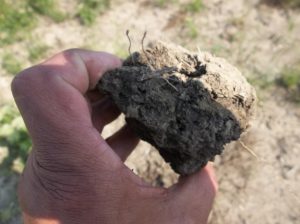Agronomy, Conservation, Homepage Slider, Precision Technology
Correcting compaction infractions below the surface
By Dusty Sonnenberg, CCA, Ohio Field Leader
It will come as no surprise to farmers that compaction issues will play a role in the future productivity of their fields after the last two growing seasons. Across Ohio, 2018 finished with a wet harvest with many farmers unintentionally committing compaction “infractions.” The equally wet spring of 2019 did not help heal the already injured soil profile, and in some areas, the fall of 2019 was also a challenge. Soil structure was severely damaged by multiple passes of heavy harvest and planting equipment. While many farmers attempt to follow controlled traffic patterns, it is not always practical when the weather only allows for brief windows of opportunity for field work.
This scenario was a text book example for both topsoil and subsoil compaction to occur according to research conducted by Randall Reeder, Ohio State University emeriti and Sjoerd Duiker, Penn State Soil Specialist. Their work has found farm equipment with high axle loads on wet soil causes compaction in both the topsoil and subsoil. This is exactly what occurred in a number of fields in Ohio since the fall of 2018.  The research also revealed that low axle loads will cause compaction in the topsoil and only the upper part of the subsoil. Contrary to popular belief, deep subsoil compaction can only partially be alleviated with subsoilers. Freezing/thawing and drying/wetting cycles have been shown not to eliminate deep subsoil compaction. Deep subsoil compaction is permanent according to the research findings. The recommendation is that deep subsoil compaction should be avoided at all costs. In a sense, the only good way to eliminate it is by not creating it in the first place. Unfortunately, many farmers realize that with the limited windows of opportunity we have experienced recently, avoiding field work in those conditions is not a realistic option. More information can be found at https://extension.psu.edu/avoiding-soil-compaction
The research also revealed that low axle loads will cause compaction in the topsoil and only the upper part of the subsoil. Contrary to popular belief, deep subsoil compaction can only partially be alleviated with subsoilers. Freezing/thawing and drying/wetting cycles have been shown not to eliminate deep subsoil compaction. Deep subsoil compaction is permanent according to the research findings. The recommendation is that deep subsoil compaction should be avoided at all costs. In a sense, the only good way to eliminate it is by not creating it in the first place. Unfortunately, many farmers realize that with the limited windows of opportunity we have experienced recently, avoiding field work in those conditions is not a realistic option. More information can be found at https://extension.psu.edu/avoiding-soil-compaction
“Compaction was a huge issue this year,” said Elizabeth Hawkins, OSU Extension, Agronomic Systems Field Specialist.
Hawkins coordinates the field-scale on-farm research for the The Ohio State University Extension Digital Ag Program known as eFields. This program is dedicated to advancing production agriculture through the use of field-scale research. The program is committed to completing research and extension activities regarding soil compaction. The program has a strong focus on researching pinch row compaction from planters (tracked vs. wheeled tractor and planter configurations), and investigating the potential of utilizing smaller equipment to limit loading while maintaining efficiency and profitability. More information can be found at https://digitalag.osu.edu/precision-ag/research-focuses/soil-compaction-management
“Precision U will have a session on Jan. 8, 2020 focusing specifically on mitigating the compaction issue,” she said.
Precision University is a program hosted by The Ohio State University and the Digital Ag Program to help farmers make better management decisions. This specific program will help those in attendance learn how to minimize compaction and maximize soil productivity from industry and academic experts. More information and to register go to https://digitalag.osu.edu/events/precision-university-2020
To share more information, the Ohio State University Extension, Agronomic Crops Network, Agronomy and Farm Management Podcast has an episode available specifically dealing with compaction. Episode 37 focuses on soil compaction. The extremely wet fall in 2018 and spring in 2019 led to field operations needing to be conducted even when soil conditions were not ideal increasing the risk of soil compaction occurring. Scott Shearer sits down to talk about soil compaction, what it is, the causes, how to avoid it, and how to mitigate it. To listen or learn about the podcast, visit go.osu.edu/AFM.